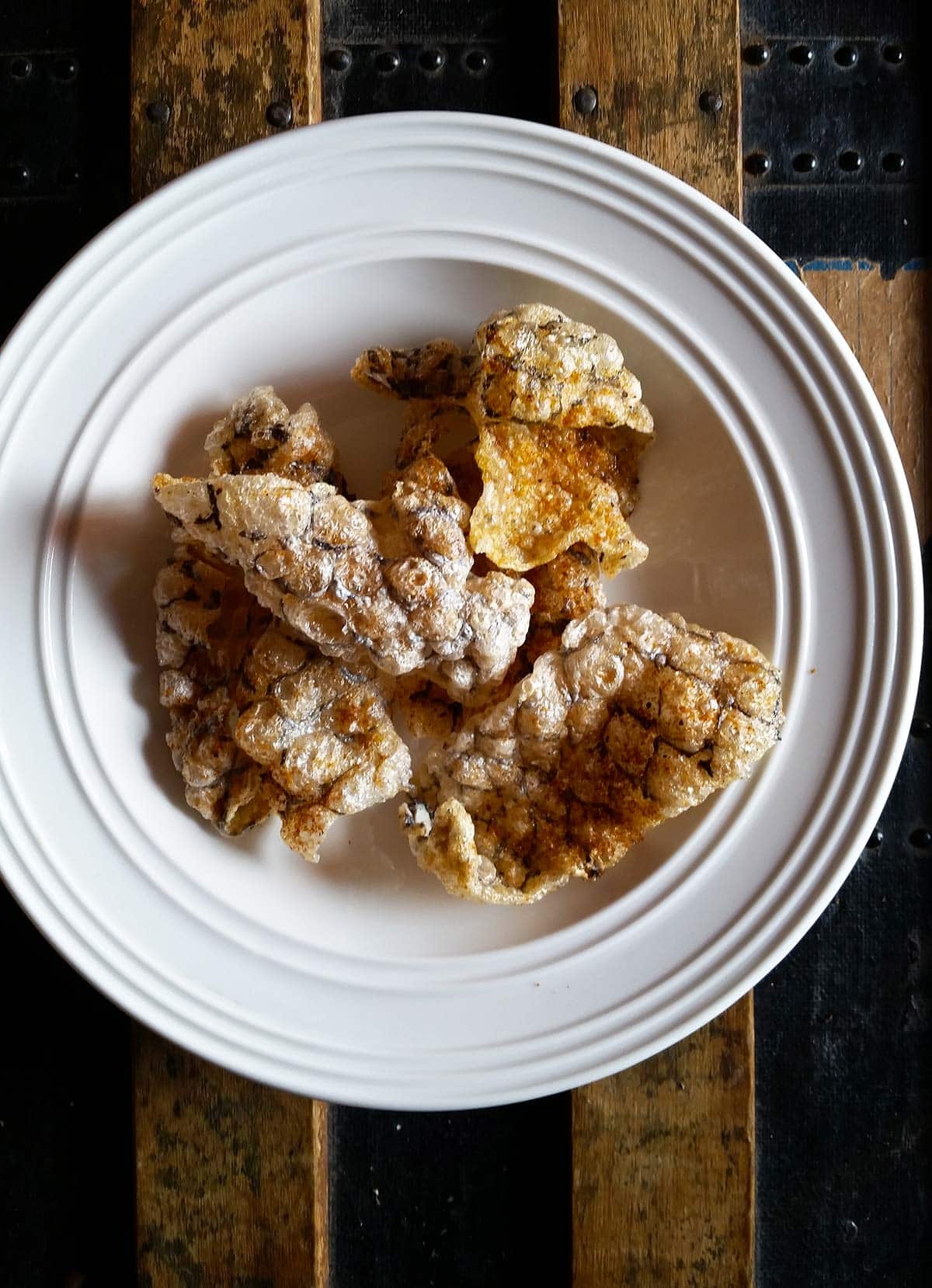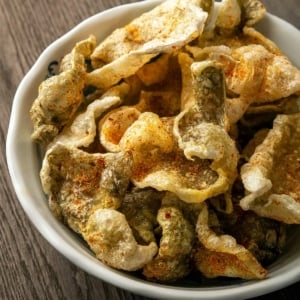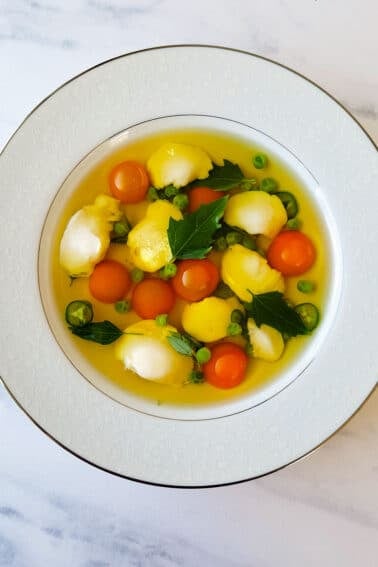As an Amazon Associate I earn from qualifying purchases.
If you’ve ever heard of pork rinds, known in Mexican cuisine as chicharrones, you know. I mean, really. Crispy, light as air, dusted with salt and whatever other flavors you have in mind. Well, these are fish skin chips, essentially the same thing. Properly made, they are so addictive they really ought to be illegal.
Fish skin chips really are every bit as good. They are light, crispy, spicy, and have an oh-so-slight briny thing going on. You know it’s fish, but it is not fishy in a bad way.

I’d vaguely heard of fish skin chips before, but never really quite knew how to make them. Then I cooked in a big Sacramento food festival called “Have an Offal Day” — yes, we all cooked nasty bits — and at this event Sacramento’s greatest sushi chef, Billy Ngo of Kru, made sturgeon skin chicharrones; there are sturgeon farms around our area, so we use sturgeon a lot here.
Billy told me how to make the chicharrones, and I was immediately obsessed. I made them for a fundraising dinner for the California Food Literacy Center and they were a hit. But then it occurred to me: Sturgeon has a thick, largely scaleless skin, and besides, not many people have access to it.
So I began working on other fish skins to see if it would work.
It does. Oh yes, folks. It does.
I am happy to report that I’ve now made fish skin chips from the skins of a huge variety of fish, from sturgeon to seabass, tripletail to porgies to walleyes. Having done this, I am pretty sure you can make fish skin chips from any skin you can slice off a fillet, meaning that ultra-thin skin like that on a mackerel might not work.
Let me walk you through the process.
Start by scaling your fish if they have scales; sturgeon, eels and sharks don’t, so you are good to go there. Scale when the fish is whole, by the way. It’s a pain to scale fish once you’ve filleted them.
Remove the skin from the meat of the fillet. You will notice that you still have some meat and fat attached to the skin. That needs to go. You also need to tenderize the skins of thick-skinned fish, like sturgeon, sharks and fish like salmon and triggerfish. You do this by boiling in salty water; the salt helps season the skins.
Here’s what I’ve found with certain skins:
- Sturgeon and leopard shark: Boil for about 3 to 5 minutes.
- Salmon I’d boil for 1 or 2 minutes, but you can scrape the skin even without cooking.
- Most bass-like fish, i.e., walleyes, rockfish, bass and perch you will only need to boil for a minute or two. They are tender already. (Here is a recipe with walleye skin chips.)
Now you need to carefully remove all the meat and fat from the skins. Gently lift the skins out of the boiling water and lay them meat side up on a cutting board. Now, using a butter knife, carefully lift and remove all the meat and fat. This is fairly tricky, and if you have oven-mitt hands you will tear the skin. Take your time until you get the hang of it.
Once you have all the meat removed, you need to dry the skins. I do this in a dehydrator at 120°F until the skin dries, which isn’t too long — about 2 to 4 hours depending on the species of fish. I’ve also greased a baking sheet and laid the skins down (meat side up) and dried them in an oven set to 170°F. You will need to flip the skins at least once if you do this option.
When the skins are dried you can save them in the freezer indefinitely.
Frying fish skin chips is easy. Heat about 1 inch of high smoke-point oil — I prefer rice bran or grapeseed oil, but canola or other vegetable oil works, too — to between 350°F and 360°F. Get your seasonings nearby, as you will have only seconds to season before the skins’ surface dries. Salt is a must, but I’ve used herbes de Provence, smoked paprika and even lemon pepper.

Drop a couple skins into the hot oil and watch the magic: They will puff up immediately in an amazingly miraculous way. They will be ready in less than a minute. Watch for the sizzling to die down dramatically. Move them to paper towels with a slotted spoon and season immediately. Once fried, fish skin chips will stay crispy for a few hours, depending on the humidity.
All I can say if you are on the fence about fish skin chips is try them. You will never look at the skin on fish in the same way again. Trust me.
Crispy Fish Skin Chips
Equipment
- 1 Dehydrator (or you can use your oven)
Ingredients
- 1 pound fish skins (see above)
- Oil for frying
- Salt
Instructions
- Make sure the skins are fully scaled. Pick off any stray scales. Cut the skins into large pieces.
- Bring a medium pot of water to a boil and add a few tablespoons of salt. Bring the water back to a boil after adding the skins and boil them for at least 1 minute, and up to 5 minutes for thick skins like sturgeon or shark. Most fish only need a minute or so.
- Remove the skins from the boiling water and lay them, meat side up, on a cutting board. Carefully, using a butter knife, scrape away all the meat and fat from the underside of the skin. This is a gentle process. You might rip the skin a few times, and that's OK. When each skin is clean, lay it on a dehydrator rack.
- Dehydrate the skins fully. You can do this at a range of temperatures. I go for about 140°F, but you can go higher or lower. You could also use your oven set on low, especially if it is a convection oven.
- When the skins are completely dry, so they snap when bent, you can fry them now or store the skin for a couple days in the fridge; you can also freeze them. Fry at 360°F one or two at a time. They will puff up instantaneously. Fry until the bubbles stop, about 30 seconds.
- The moment they come out of the fryer, dust with salt and whatever other seasoning you like. I love using Mexican Tajin.
Nutrition
Nutrition information is automatically calculated, so should only be used as an approximation.







Well Hank, we’ve done it again. You spoke, and I followed. Sorta. I stumbled into your crispy fish skin recipe a while ago, and stored it in the back of my mind. I just ordered a bunch of salt cod from Portugalia in Falls River, MA (and linguica and a bunch of tin fish, but that’s another story.) I soaked several large chunks of cod (skin on) for two days. After 2 days (which was about 1 hour ago), I cut them into portion sizes with a fillet knife, cut out bones, and removed skins. I put the cod pieces back into clean water, where they will sit until tonight or probably tomorrow, and meet the Linguica, kale and potatoes. So I quickly poached the remaining scraps of fish to taste, removed and spooned over a little butter and parsley, and they were delish, though it confirmed the fish could soak another few hours or overnight. Then I got thinking about your crispy fish skin recipe. I actually forgot about the dehydrator part, but wouldn’t have done that with the few pieces I had anyways. I did, as you suggest, scrape all the meat off with a fillet knife. Since the cod had soaked for two days, scraping any remaining meat off was easy. I used olive oil, which of course I usually don’t use for frying, but it performed just fine for the task. The fish skins were delicious. Delicious – – closer to fish skins from a broiled fish than cracklings, but still crispy, curled, a little puffy. But delicious. Didn’t use any seasoning since it was salted, and it didn’t need anything else. Will make this a regular practice with salt cod and next time I have an abundance of other fish skins, do the Hank Full Monty recipe using the dehydrator first. Thanks as always.
can u use tuna skin too?? just curious :p
Monica: Not sure. Never tried it with tuna skin.
I make crispy salmon skins to go with baked sushi, but use a different method. I’m lucky my husband had a fish skinner tool that stripped the skin off easily. I then scraped any tissue or fat off it
After rinsing and patting it dry I placed it on one side of folded parchment paper then rubbed it with soy sauce and wasabi on both sides. Then with it sandwitched in the parchment paper I put another baking sheet on top to prevent curling and baked it my toaster oven at 325° for 35 minutes or until it was crispy and golden brown. I used to make furikake as well as to crumble on top of baked sushi. But it was also a great snack too. I will have to try other fish and use your method.
Did you ever try to make the fishskin from trouts? What do you think will it work?
Maurus: It doesn’t work as well because there seems to be a lot of fat in trout skin. It will get crispy and delicious, but it doesn’t puff up well.
I have the same query as April…… I don’t have a dehydrator, so I would use the oven option. How long are they in the oven for?
Debbie: Until they are dry and hard. I have no idea, maybe 2 or 3 hours?